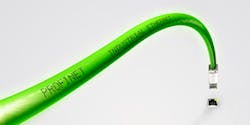Five Criteria to Consider when Choosing an Industrial Ethernet
Over the last few months, I’ve attended more than my fair share of trade shows and training events, and encountered device vendors and users pondering an industrial Ethernet solution. This prompted me to summarize the case for choosing PROFINET, with these five criteria as most important.
• Performance
• Scope
• Widely Used
• Globally Supported
• Certification
Criteria 1: Performance
For most architectures, PROFINET is the fastest performer. EtherCAT is faster in some smaller systems; see my report on a paper on the topic. Of course PROFINET is enhancing the protocol for those situations, too. PROFINET takes four steps to achieve increasing levels of determinism.
Step 1—TCP/IP: Yes, PROFINET uses TCP/IP, but only for non-time-critical data like configuration and diagnostics.
Step 2—Layer 2: For time-critical data, PROFINET takes the simple step of skipping the TCP and IP layers to move data directly from Ethernet to the application. This drastically improves performance and determinism. See my PROFIblog for the seven-layer model and our approach.
Step 3—Bandwidth Reservation: The first two steps are sufficient for 90 percent of applications, but when you really need guarantees of sufficient bandwidth for data delivery (regardless of other network traffic), PROFINET introduces bandwidth reservation. Motion Control and some IO needs are in this category. We literally just reserve some time on the network for this data.
Step 4—Scheduling: Motion Control needs one additional step. Knowing the network topology, the PROFINET configuration tool ensures that the data to the device farthest away is sent first.
Criteria 2: Scope
As a user of Industrial Ethernet, I want to pick just one protocol that covers all my requirements. PROFINET of course covers IO, but also covers motion control, safety over the network, peer-to-peer integration, vertical integration, and the integration of PROFIBUS and many other fieldbuses. By choosing PROFINET, the user is assured that he won’t get stuck adding a second protocol for one of those functions. Adding a second protocol would be expensive in terms of configuration and diagnostic tools, but even more expensive in terms of training.
Criteria 3: Widely Used
The more widely used a technology, the longer its lifespan will be. More devices will be available and more knowledgeable people will be there to support it. PROFINET is destined to be the most widely used Industrial Ethernet. While our market numbers show that PROFINET has one-third share of the industrial Ethernet market, I expect that market share to increase dramatically. Look at PROFIBUS with now over 30,000,000 devices installed and which translates to something like 50 percent market share for fieldbus networking. Then consider the second most popular fieldbus, Interbus, with over 20 percent market share. Both those technologies migrate to PROFINET. With almost three quarters market share of the serial fieldbus market moving to PROFINET, it’s clear to me that PROFINET will be the dominant Industrial Ethernet.
Criteria 4: Globally Supported
The world is flat again. If you make machinery, you probably ship it worldwide. If you use machinery, you probably have plants worldwide. In either case, you need to be sure that wherever in the world you are, you can get support for the technology you chose.
PI (PROFIBUS and PROFINET International) has created the concept of a PI Competence Center (PICC). We now have 47 of them around the world. Here in North America, our PICC is the PIC (PROFI Interface Center) in Johnson City, TN. It exists to help users understand and use PROFIBUS and PROFINET and to help device manufacturers add them to their products. These duties parallel and complement what we do at the PTO, which is one of 25 Regional PI Associations around the world.
Criteria 5: Certification
How can I be sure, in a world that’s constantly changing? Well, I guess you can’t be sure of everything, but one thing you can be sure of is the competence of our Competence Centers. PI certifies them. Each PICC must meet stringent requirements and sign a Quality of Service agreement. They are personally visited and qualified and then audited every other year to ensure the standards continue to be met. PI does the same with Test Labs and Training Centers. We even certify network engineers that attend our week-long training class and pass rigorous theoretical and practical exams. So you can conclude (along with The Young Rascals) of PROFINET “I’ll be sure with you.”
For more information on PROFINET, visit www.us.profinet.com.

